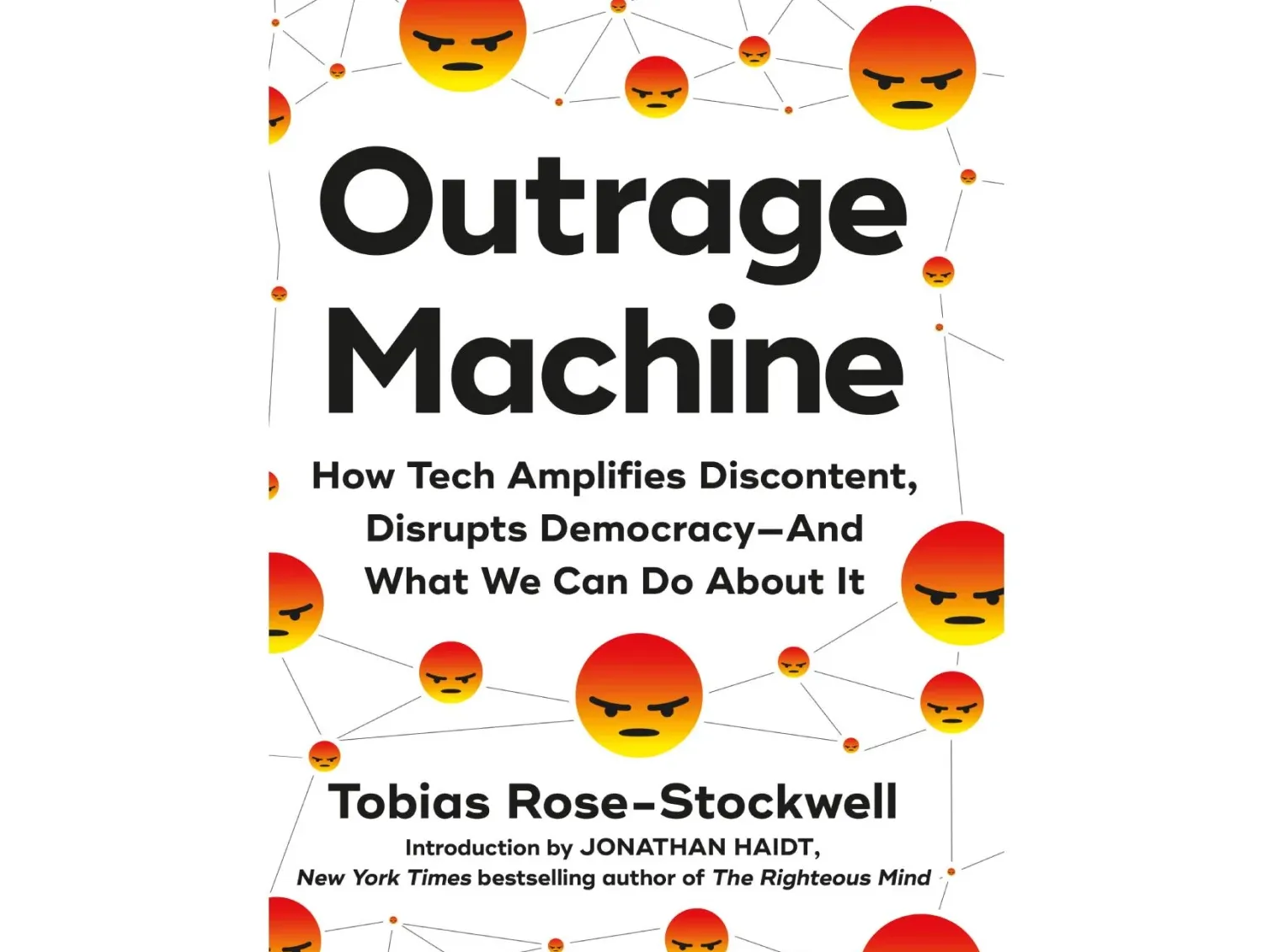The Dangers of Our Online Attention Economy: Examining the Real-World Consequences of Spending Too Much Time on the Internet
The rise of reality television has shown us that people are willing to do almost anything for money and attention, or even just attention alone. Unfortunately, social media has taken advantage of these human tendencies and amplified them on a global scale, prioritizing audience growth and engagement above all else. In his book Outrage Machine, Tobias Rose-Stockwell explores how modern technologies are designed to capture and hold our attention, no matter the consequences. In the following excerpt, Rose-Stockwell delves into the negative impact of feeding the content machine by discussing the journey of YouTube personality Nikocado Avocado towards internet fame.

Excerpt from OUTRAGE MACHINE: How Technology Amplifies Discontent, Disrupts Democracy – and What We Can Do About It by Tobias Rose-Stockwell. Copyright © 2023 by Tobias Rose-Stockwell. Reprinted with permission from Legacy Lit. All rights reserved.
This game is not just a game
Social media can feel like a game. When we open our app and create a post, the way we aim to score points in the form of likes and followers clearly resembles a new weird playful competition. But even though it feels like a game, it is unlike any other game that we can play in our spare time.
Academician C. Thi Nguyen has explained how games differ from each other: “The functions of games are distinguished in an important way from ordinary life. When we’re playing basketball and you block my pass, I don’t take it as a sign of your lingering animosity toward me. When we play in an insult contest, we don’t take each other’s speech as an indication of our real attitudes or beliefs about the world.” Games take place in what Dutch historian Johan Huizinga famously called a “magic circle”—where players take on alternate roles and our actions have alternate meanings.
With social media, we’re never out of the game. Our phones are always with us. We do not detach ourselves from the mechanics. And since the goal of social media game designers is to keep us there for as long as possible, it is an active competition with real life. Because of constant habitual attention to metrics, we never leave these digital spaces. This is how social media has conquered our world with its game mechanics.
Meters are money
While we get paid for the little dopamine spikes that come from collecting abstract numbers, the metrics also turn into hard cash. Acquiring these metrics doesn’t just give us emotional validation. They are transferable to a financial value that is measurable and very real.
It’s no secret that the ability to consistently command attention is an asset that brands pay for. A successor is a tangible, marketable asset worth money. If you’re trying to buy followers, Twitter will charge you $2-$4 to get a new one using their promoted account.
If you have enough followers, brands will pay you to post sponsored products for them. For example, depending on the size of your following on Instagram, these fees can range from $75 per post (for an account with two thousand followers) to hundreds of thousands of dollars per post (for accounts with hundreds of thousands of followers). .
Between 2017 and 2021, the average cost to reach 1,000 Twitter users (the metric used by advertisers is cost per thousand impressions) was between $5 and $7. It costs so much to get a thousand eyeballs on your post. Any strategy that increases the sharing of your content also has financial value.
Now let’s take this financial incentive back to Billy Brady’s view of the value of engaging in moral outrage. He found that adding one moral or emotional word to a post on Twitter increased the spread of the content by 17 percent per word. All of our social media posts are there to get attention – they compete for the top of followers’ feeds. Our posts are always competing against other people’s posts. If outraged posts have an edge in this race, they’re literally worth more.
For a brand or individual, if you want to increase the value of a post, moral outrage or linking to a larger movement that expresses its moral convictions might increase the reach of that content at least that much. Moreover, it may actually improve perception and brand affinity by appealing to the moral foundations of the brand’s consumers and employees, increasing sales and enhancing their reputation. This can be an inherently polarizing strategy, as a company that chooses a cause to support and has a morally diverse audience may then alienate a significant portion of its customer base that disagrees with that cause. But these economics can also make sense – if a company knows enough about the moral connections between consumers and workers – it can ensure that it chooses a cause sector that aligns with its customers.
Since moral content is a reliable tool for capturing attention, it can also be used for psychographic profiling for future marketing opportunities. Many big brands do this with tremendous success – creating viral campaigns that leverage moral righteousness and outrage to gain traction and attention among key consumers with a similar moral stance. These campaigns also often get a secondary boost from the proliferation of pileons and think tanks discussing these ad spots. Brands that moralize their products often succeed in the attention market.
This basic financial incentive may help explain how and why so many brands have come to associate themselves with issues related to online causes. While it may make strong moral sense to these decision makers, it may also make clear financial sense to the company as a whole. Social media offers measurable financial incentives for companies to incorporate moral language into their efforts to improve their branding and perceptions.
But as disgusting as this sounds, moralizing content is not always the result of mindless manipulation and greed. Social metrics do something else that affects our behavior in harmful ways.
Audience abduction
In the final days of 2016, I wrote an article about how social media was eroding our ability to empathize. After the presidential election that year, the article went viral and was shared with several million people. I was working on other projects full time at the time. Once the article took off, I shifted my focus away from years of consulting work and began to focus on full-time writing instead. One of the byproducts of this huge signal from this new audience is the book you are reading right now.
A large new audience of strangers had given me a clear message: This was important. Do more of it. When lots of people we care about tell us what we should do, we listen.
This is the result of “audience capture”: how we influence and are influenced by observers. We not only capture the audience, but also their feedback. This is often a great thing that prompts us to produce more useful and interesting works. As content producers, the signal from our audience is a huge part of why we do what we do.
But it also has a dark side. Author Gurwinder Boghal has explained the phenomena of audience capture to influencers, illustrating the story of a young YouTuber named Nicholas Perry. In 2016, Perry started a YouTube channel as a skinny vegan violinist. After barely reaching the web for a year, he abandoned veganism due to health concerns and switched to uploading mukbang (eating show) videos where he tried different foods for his followers. These Followers began to demand more and more extreme feats of food consumption. Before long, trying to appease his increasingly demanding audience, he posted videos of himself eating entire fast food menus in one sitting.
He found a large audience with this new format. In terms of metrics, this new format was overwhelmingly successful. After several years of following the constant requests of his audience, he amassed millions of followers and over a billion views. But at the same time, his online identity and physical character changed dramatically. Nicholas Perry became the persona Nikocado—an obese parody of himself who weighed over four hundred pounds and voraciously ate whatever his audience asked him to eat. Complying with the wishes of his audience led him to commit increasingly extreme acts at the expense of his mental and physical health.

Nicholas Perry, left, and Nikocado, right, after several years of building a following on YouTube. Source: Nikocado Avocado YouTube channel.
Boghal summarizes this cross-directional effect.
When influencers are analyzing audience feedback, they often find that their more outlandish behavior receives the most attention and approval, which leads them to recalibrate their personalities according to far more extreme social cues than those they’d receive in real life. In doing this they exaggerate the more idiosyncratic facets of their personalities, becoming crude caricatures of themselves.
This doesn’t just have to apply to influencers. We are signal processing machines. We respond to the positive signals we receive from those who observe us. Our audience online reflects back to us what they think of our behavior and we adapt accordingly. The metrics we now have available on social media (likes, followers, shares and comments) allow us to measure this feedback much more precisely than we could before, leading us to internalize “good” behavior.
As we increasingly find ourselves within these online spaces, this effect is accentuated. As Boghal points out, “We all have an online audience.” Whenever we post to our followers, we’re beginning an exchange process with our viewers—a process that involves the same extreme engagement issues found everywhere else on social media.




